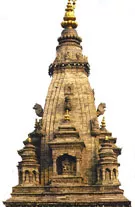The Newar Synthesis
 Ask a Newar whether he's Hindu or Buddhist, the saying goes and he'll answer "yes": after fifteen centuries of continuous exposure to both faiths, the Newars of the Kathmandu Valley have concocted a unique synthesis of the two. To religious scholars, the Newar religion is as exciting as a biologist's missing link, for some believe that it provides a picture of the way Mahayana and Vajrayana Buddhism functioned historically in India.
Ask a Newar whether he's Hindu or Buddhist, the saying goes and he'll answer "yes": after fifteen centuries of continuous exposure to both faiths, the Newars of the Kathmandu Valley have concocted a unique synthesis of the two. To religious scholars, the Newar religion is as exciting as a biologist's missing link, for some believe that it provides a picture of the way Mahayana and Vajrayana Buddhism functioned historically in India.
Until only the past two centuries, the Newars held fast to original monastic form of tantric Buddhism – as the bahal of Kathmandu and Patan still bear witness – while their rulers pursued the Hindu tantric path. However, the Kathmandu Valley has become progressively "Hinduized" since the unification of Nepal in the eighteenth century: the monasteries have largely disappeared, their monks have married, and the title of Vajracharya (Buddhist Priest) has become a hereditary caste like that of the Bahun (Brahman) priests. Today, Newar Buddhists are perhaps the only Buddhist culture that no longer maintains active communities of monks or nuns. Although the acceptance of caste and decline of monasticism have shifted the balance in favor of Hinduism, at the popular level the synthesis remains as well bonded as ever.
When Newars refer to themselves as Buddha Margi (Buddhist) or Shiva Margi (Hindu), they often do so only to indicate that they employ a Vajracharya or Bahun priests; even this does not hold true, though, as many jyapu (farmers) call themselves "Hindu" and attend Hindu festivals, yet still use Vajracharyas. In any case, Newar rituals vary little from Hindu to Buddhist.
Puja (an act of worship) is performed to gain the favor of deities for material requests as often as for "spiritual" reasons. It is a profound and very personal ritual. An integral part of all Newar rituals is the "puja of five offerings", consisting of flowers (usually marigolds), incense, light (in the form of butter lamps), sindur (colored powder) and various kinds of purified food (usually rice, dairy products, sometimes sweets). Before darshan (audience with a deity), the devotee or the priest uses consecrated water to wash him or herself and to bathe the deity. After the deity has symbolically accepted and eaten some food, the remainder is taken back by the devotee as prasad (consecrated food). This, along with a tika made with the colored powder, confers the deity's blessing and protection.
Priests are ordinarily engaged for the more important life-cycle rites (birth, marriage, death) or for larger seasonal festivals; wealthier Newars may also seek private consultations at times of illness or important decisions. Bahun priests don't perform animal sacrifices, but they do preside over the rituals that precede them. This brings up one of the rare differences between Hindu and Buddhist Newars : while Hindu Newars are enthusiastic sacrificers – they call the bloody ninth day of Dasain festival Syako Tyako (roughly, "the more you kill, the more you gain") – Buddhists seldom participate. During dasain, Tibetan monasteries in Nepal hold special services to pray for good rebirths of the sacrificed animals.